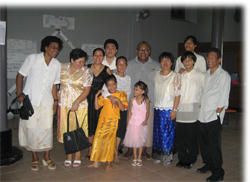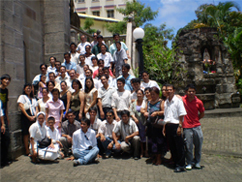Everyday Life With Muslims
By Rowena Cuanico
Since 1 June the author has been Lay Mission Coordinator in the Philippines.
This Filipina grew up around Muslims, but only learned about the people and their faith as a Columban lay missionary.
 As a child in the Philippines, there were about 30 Muslim families, mostly traders, who lived in my hometown. Two of these families were family friends, but I never had the courage to learn more about Islam and the lives of my Muslim neighbors.
As a child in the Philippines, there were about 30 Muslim families, mostly traders, who lived in my hometown. Two of these families were family friends, but I never had the courage to learn more about Islam and the lives of my Muslim neighbors.
I had uneasy feelings about Muslims, largely because of the ongoing conflict between Christians and Muslims on the island of Mindanao, the Philippines’ large southern island where about four million Muslims live.
The images and stories I have heard from the media about the conflict are terrible and gruesome. The strife in Mindanao has claimed many innocent lives, displaced thousands and retarded the development of this resource-rich island. There have been signs of hope and peace — peace talks, peace agreements and cease-fires. But oftentimes, these signs quickly disappear.
Being a Columban Lay Missionary
As a Columban lay missionary, part of our formation program in the Philippines was an exposure trip to the Prelature of Marawi in northwestern Mindanao, a part of the island where Columban missionaries have worked for decades. In Marawi City, about 95 percent of the people are Muslims.
 The exposure provided us with a rare opportunity to meet Columbans who are involved in the ‘dialogue of life’, promoting understanding, unity and peace between Christians and Muslims. The late Columban Father Des Hartford, who was then the apostolic administrator of the Prelature of Marawi, and Columban Father Paul Glynn led our immersion experience.
The exposure provided us with a rare opportunity to meet Columbans who are involved in the ‘dialogue of life’, promoting understanding, unity and peace between Christians and Muslims. The late Columban Father Des Hartford, who was then the apostolic administrator of the Prelature of Marawi, and Columban Father Paul Glynn led our immersion experience.
We arrived in Marawi on a Saturday morning with ‘Monsignor Des’, as we used to call him. We, six lay missionaries-in-training, were fully covered: wearing scarves on our heads, loose pants and long-sleeved blouses. Despite Father Paul’s preparations, there was really nothing that could prepare us for what the experience would be like.
At the time of our visit, the military was on high alert. We were told to simply follow instructions. We couldn’t go out on our own. From the outside, the cathedral in Marawi looked like a big warehouse to me.
On our second day, we went to the Muslim families who were to host us for two days. Columban lay missionary Jennifer Chan and I had all our ‘cultural and religious notes’ in mind, prompting us on what to do next.
But it was the warmth of the family’s amazing welcome that calmed my anxiety and overcame my fears. The family made every effort to make us feel comfortable during our short stay.
Inter-faith living in Fiji
The six of us, lay missionaries from the Philippines, later arrived in the South Pacific island nation of Fiji for missionary work. I never expected that I would be involved in ‘interfaith dialogue’.
When Beth Briones and I reported to Holy Family Parish in Labasa, mosques, temples, mandirs (Hindu temples) and churches were everywhere. And in the Holy Cross Catholic community in Naleba, our immediate neighbors included three Muslim and three Hindu families.
I knew I was unprepared for the experience and would have to learn along the way. But, again, it was the welcoming hearts of the people that made the difference.
When I was assigned to St Pius X Parish in Fiji’s capital city of Suva, I lived in an apartment at the back of the home owned by Mrs Singh and her daughter, who are Hindus of Indian descent.
When Mrs Singh died last year, a young Muslim family, who used to live in my room, moved into the main house. They are Zabiir, Safiya and their 6-year-old son, Zameer. Safiya used to work in the preschool in the parish.
During the celebration of the month of Ramadan in 2004, I heard sounds coming from their kitchen as early as 2:30 in the morning as Safiya would prepare food. Then, I would hear the prayers from a radio broadcast; then, they would pray.
After cleaning up, Zabiir would be off to work and Zameer to kindergarten. Safiya would then do the rest of the household chores. I would always be surprised to see how much strength she had to do all those chores.
During Ramadan, the Islamic month of fasting, I cooked food only in the morning or in the evening. I would seldom cook at lunchtime. For me, it was one way of showing solidarity with the family and Ramadan’s fasting requirements that they observed. I had nothing but admiration for them and their discipline and commitment to pray and fast. (Editor’s note: This year Ramadan coincides with the month of September.)
Celebrating Christian and Muslim Holidays
On the last day of Ramadan, called the Eid al-Fitr, Columban Father Pat McCaffrey and I joined the family for its wonderful celebration. Father Pat, who spent twenty years in Pakistan, greeted them in the Urdu language, and their son Zameer was so mesmerized he could hardly say a word. Not even a word in Hindi would come out of his mouth.
They offered us Indian miTThai (sweets) and the traditional samay (a noodle dish). Father Pat read aloud a souvenir program about Ramadan written in Urdu and said the opening verses of the Quran. They were awed and, to a certain extent, shocked.
It was a beginning of their friendship with Father Pat and a deepening of ours.
I have come to know some of the members of their families, and they have come to know mine, even if only in name. We exchanged gifts during Christmas and had a barbecue on New Year’s Day. I was even a part of the two weddings in their family, including the wedding of Safiya’s sister.
Safiya and I would discuss our faiths. She knew the schedule of Masses in the parish and the 24-hour adoration of the Blessed Sacrament from Thursday morning to Friday.
When I was coming home from Mass one Friday morning, Safiya told me that they saw people praying in church that night. I explained about the Eucharistic adoration, and she asked if I had participated.
After I told her that I had prayed earlier during the day, she even had the courage to rebuke me for not praying with the community that night!
Through my experiences, I have come to know Muslims better. I had to come all the way to Fiji to know the lives of Muslims even though Muslims lived in my childhood neighborhood.
I have learned there are no recipes for a meaningful interfaith dialogue. I do not even talk about interfaith dialogue; I just try to live it. This comes with the joy of being welcomed and accepted and sometimes the pain of being misunderstood and even rejected. Interfaith dialogue is simply an exchange of what is in our hearts.
You may email the author at rowenacuanico@gmail.com or write her at: St Columban's Lay Mission Center, 34 Rosario Drive, Cubao, 1111 Quezon City, Philippines
